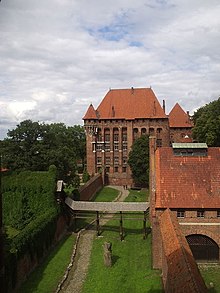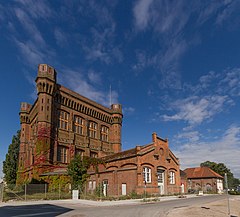Water tower on the Werder
| Water tower on the Werder (Bremen) | |
|---|---|
| Data | |
| Construction year: | 1871 to 1873 |
| Architect: | Rudolph Berg and Johann Poppe |
| Monument protection: | Cultural monument since 1978 |
| Tower height: | 47 m |
| Usable height: | ? |
| Container: | Two steel flat-bottom containers (riveted) with the dimensions 23 m × 13 m × 3.5 m |
| Volume of the container: | 1700 m³ |
| Shutdown: | 1983 |
| Original use: | Urban water supply |
| Todays use: | Occasionally used for exhibitions and theater productions. |
The water tower on the Werder on Werderstrasse is the oldest water tower in the city of Bremen . The 47 meter high building - also popularly known as the “upside down dresser” - on the Stadtwerder was part of the Bremer Wasserkunst with the operator swb AG .
prehistory
The first central water supply was built in Bremen in 1394. A bucket wheel was attached to the Weser bridge. A pipe system directed the water to 200 houses in the city. The wheel, driven by the flowing water, later by horse pegs , was one of the city's sights. It was not always in operation and had to be renewed several times. A large model is in the Focke Museum in Bremen. In 1822 the operation was stopped and in 1847 it was temporarily replaced by a steam-powered pump.
Construction and operation of the facility
With the growth of the population due to the industrialization of the 19th century, Bremen needed a more efficient water supply. Rudolph Berg was entrusted with the technical planning and construction, while Johann Georg Poppe was commissioned with the architectural planning . In the first decades of operation, water from the Weser was taken from here and cleaned in sand filter systems.
When the system went into operation and initially only supplied 2,000 house connections, the population of Bremen just passed the 100,000 mark. Ten years later, almost half of all households in Bremen were connected to the water supply. It was not until 1908 that all houses in Bremen had a direct water connection.
The water tower
The water tower was built between 1871 and 1873. The size of the structure is reminiscent of the Malakow towers in the Ruhr mining area . The design for the historicizing building was inspired by the Grand Master 's Palace of the Marienburg Order Castle in East Prussia . Its proportions and the four corner turrets, which rise like legs into the sky, gave rise to the nickname "upside down dresser". The corner towers were shortened decades ago because they were dilapidated. With steam engine driven pump systems have the purified Weser water conveyed into the located in the upper part of the tower vessel. Two of the four towers served as chimneys for the steam engines. The third tower serves as an entrance. In the fourth there are pipelines.
The tower no longer fulfills its original purpose. The waterworks was given up in 1983 and only served as a water reservoir for the supply of the Beck & Co. brewery from the long-distance networks of the Harz waterworks .
On October 27, 2008, the remaining 800,000 liters were drained from the water tank into the drinking water network. Before that, 100 bottles were filled with the label "swb AG Exclusivabfüll - swb water from the venerable water tower Auf dem Werder".

Interim use and future use
The building was sold for a new use as a "lighthouse project" for a residential and office district on Stadtwerder . The handover took place in October 2008. A total of 220 residential units are to be built on the former waterworks site at the “upside down dresser”.
In 2011, the building for art projects was between used . The cultural project Schwankhalle and the Shakespeare Company , with the support of the Senator for the Environment, Building, Transport and Europe and the Heinrich Böll Foundation, brought the traveling exhibition "Recommended for imitation!" in the water tower on the Stadtwerder . The exhibition was about sustainability and its aesthetics. The exhibition was accompanied by an extensive supporting program with artist talks, panel discussions and a film program.
literature
- Emil Böttcher and H. Ohnesorge: The waterworks of the Free Hanseatic City of Bremen. In: Zeitschrift für Bauwesen 26 (1876), Sp. 343–356, 493–522, Bl. MO, Atlas Digitalisat
- Nils Aschenbeck , Jens U. Schmidt: Water towers in the northwest. Isensee, Oldenburg 2003, ISBN 3-89995-006-2 .
- Christine Backhaus: From water art to water management. Forays into the present, history and future of (drinking) water in Bremen. 125 years of drinking water supply in Bremen. Hauschild, Bremen 1998, ISBN 3-89757-002-5 .
- Jens U. Schmidt: Water towers in Bremen and Hamburg. Hanseatic water towers . Regia-Verlag, Cottbus 2011, ISBN 978-3-86929-190-1 .
- Herbert Black Forest : The Great Bremen Lexicon . 2nd, updated, revised and expanded edition. Edition Temmen, Bremen 2003, ISBN 3-86108-693-X .
- swb AG (Ed.): 150 Years - From Enlightenment and Waterworks to swb.
- Water - On the history of the drinking water supply in Bremen . Catalog for the special exhibition Focke-Museum Bremen 1988
- Alfred Ohl: The water supply of the Free Hanseatic City of Bremen - 100 years of central water supply 1873-1973 . Bremen 1973.
Web links
- Bremer Trinkwasser - a high quality food on bremen.de
Individual evidence
- ↑ a b c Monument database of the LfD
- ↑ Herbert Schwarzwälder: The water wheel on the Bremen Weser bridge. In: Wasser, catalog Focke-Museum 1988, pp. 15–49
Coordinates: 53 ° 4 ′ 6 ″ N , 8 ° 48 ′ 37 ″ E



